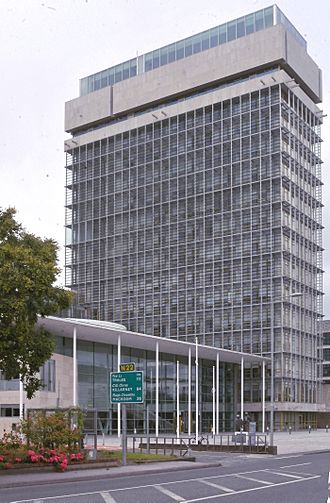County Hall, Cork facts for kids
Quick facts for kids Cork County Hall |
|
|---|---|
|
Halla an Chontae, Corcaigh
|
|

Cork County Hall
|
|
| General information | |
| Address | Carrigrohane Road |
| Town or city | Cork |
| Country | Ireland |
| Construction started | 1965 |
| Completed | 1968 |
| Design and construction | |
| Architect | Patrick McSweeney |
The County Hall (which means Hall of the County in Irish) is a tall, 17-storey office building. It is owned by Cork County Council and serves as their main office. This important building is located on Carrigrohane Road in Cork City. Even though it's in Cork City, it's actually the headquarters for the Cork County Council, which manages the wider county area.
When it was finished, the County Hall stood at 67 meters (about 220 feet) tall. This made it the tallest building in Ireland at the time! Since then, a few other buildings have become taller. Today, the County Hall is considered a protected building, meaning it's important and its special features are kept safe.
A Look Back: How County Hall Began
For a long time, meetings for Cork County Council were held in a small part of the Cork Courthouse. By the 1950s, this space was becoming too small for all their work. They needed a bigger, special building just for the council.
So, in 1965, work began on a brand new building. It was designed by Patrick McSweeney, who was the Cork County Architect at that time. The new County Hall was officially opened in April 1968. Outside the building, you can see a famous statue called Two Working Men by the artist Oisín Kelly.
Modern Makeover: The County Hall's New Look
In 2002, a big project started to give the County Hall a modern update. The outside of the building, which was made of concrete, was starting to wear out. Instead of just fixing it, they decided to replace it and make the building even better.
The old concrete was replaced with shiny glass panels. They also added a new floor to the top of the tower! A new six-storey extension was built next to the main tower. This big update also included a new entrance area and a special room for council meetings. The whole project was finished in June 2006 and cost about €50 million.

